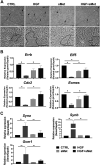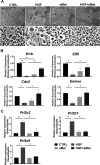HGF/c-Met signaling regulates early differentiation of placental trophoblast cells
- PMID: 33455972
- PMCID: PMC8075731
- DOI: 10.1262/jrd.2020-107
HGF/c-Met signaling regulates early differentiation of placental trophoblast cells
Abstract
Depletion of hepatocyte growth factor (HGF) or mesenchymal-epithelial transition factor (c-Met) in mice leads to fetal lethality and placental maldevelopment. However, the dynamic change pattern of HGF/c-Met signaling during placental development and its involvement in the early differentiation of trophoblasts remain to be elucidated. In this study, using in situ hybridization assay, we elaborately demonstrated the spatial-temporal expression of Hgf and c-Met in mouse placenta from E5.5, the very early stage after embryonic implantation, to E12.5, when the placental structure is well developed. The concentration of the soluble form of c-Met (sMet) in maternal circulation peaked at E10.5. By utilizing the induced differentiation model of mouse trophoblast stem cells (mTSCs), we found that HGF significantly promoted mTSC differentiation into syncytiotrophoblasts (STBs) and invasive parietal trophoblast giant cells (PTGCs). Interestingly, sMet efficiently reversed the effect of HGF on mTSC differentiation. These findings indicate that HGF/c-Met signaling participates in regulating placental trophoblast cell fate at the early differentiation stage and that sMet acts as an endogenous antagonist in this aspect.
Keywords: Hepatocyte growth factor (HGF); Mesenchymal-epithelial transition factor (c-Met); Placenta; Soluble form of c-Met (sMet); Syncytiotrophoblast cells; Trophoblast giant cells.
Conflict of interest statement
The authors declare no conflict of interest.
Figures







Similar articles
-
Placental villous mesenchymal cells trigger trophoblast invasion.Cell Adh Migr. 2014;8(2):94-7. doi: 10.4161/cam.28347. Cell Adh Migr. 2014. PMID: 24622731 Free PMC article.
-
Self-control of HGF regulation on human trophoblast cell invasion via enhancing c-Met receptor shedding by ADAM10 and ADAM17.J Clin Endocrinol Metab. 2012 Aug;97(8):E1390-401. doi: 10.1210/jc.2012-1150. Epub 2012 Jun 11. J Clin Endocrinol Metab. 2012. PMID: 22689693
-
Ontogeny of hepatocyte growth factor (HGF) and its receptor (c-met) in human placenta: reduced HGF expression in intrauterine growth restriction.Am J Pathol. 1998 Oct;153(4):1139-47. doi: 10.1016/S0002-9440(10)65658-1. Am J Pathol. 1998. PMID: 9777945 Free PMC article.
-
Roles of mesenchymal-epithelial interactions and hepatocyte growth factor-scatter factor (HGF-SF) in placental development.Rev Reprod. 1996 Sep;1(3):144-8. doi: 10.1530/ror.0.0010144. Rev Reprod. 1996. PMID: 9414451 Review.
-
Hepatocyte growth factor/MET in cancer progression and biomarker discovery.Cancer Sci. 2017 Mar;108(3):296-307. doi: 10.1111/cas.13156. Cancer Sci. 2017. PMID: 28064454 Free PMC article. Review.
Cited by
-
Mechanisms of ductular reaction in non-alcoholic steatohepatitis.World J Gastroenterol. 2022 May 21;28(19):2088-2099. doi: 10.3748/wjg.v28.i19.2088. World J Gastroenterol. 2022. PMID: 35664038 Free PMC article. Review.
-
Cannabidiol Exposure During Rat Pregnancy Leads to Labyrinth-Specific Vascular Defects in the Placenta and Reduced Fetal Growth.Cannabis Cannabinoid Res. 2024 Jun;9(3):766-780. doi: 10.1089/can.2023.0166. Epub 2024 Feb 16. Cannabis Cannabinoid Res. 2024. PMID: 38364116 Free PMC article.
-
Spatial multiomic landscape of the human placenta at molecular resolution.Nat Med. 2024 Dec;30(12):3495-3508. doi: 10.1038/s41591-024-03073-9. Epub 2024 Nov 20. Nat Med. 2024. PMID: 39567716
-
Hypoxic stress disrupts HGF/Met signaling in human trophoblasts: implications for the pathogenesis of preeclampsia.J Biomed Sci. 2022 Feb 3;29(1):8. doi: 10.1186/s12929-022-00791-5. J Biomed Sci. 2022. PMID: 35114998 Free PMC article.
-
ISRIB facilitates the co-culture of human trophoblast stem cells and embryonic stem cells.Cell Prolif. 2024 Jun;57(6):e13599. doi: 10.1111/cpr.13599. Epub 2024 Jan 12. Cell Prolif. 2024. PMID: 38217296 Free PMC article.
References
-
- Ma WW, Adjei AA. Novel agents on the horizon for cancer therapy. CA Cancer J Clin 2009; 59: 111–137. - PubMed
-
- Bottaro DP, Rubin JS, Faletto DL, Chan AM, Kmiecik TE, Vande Woude GF, Aaronson SA. Identification of the hepatocyte growth factor receptor as the c-met proto-oncogene product. Science 1991; 251: 802–804. - PubMed
-
- Stoker M, Gherardi E, Perryman M, Gray J. Scatter factor is a fibroblast-derived modulator of epithelial cell mobility. Nature 1987; 327: 239–242. - PubMed
-
- Nakamura T, Nishizawa T, Hagiya M, Seki T, Shimonishi M, Sugimura A, Tashiro K, Shimizu S. Molecular cloning and expression of human hepatocyte growth factor. Nature 1989; 342: 440–443. - PubMed
-
- Jiang WG, Martin TA, Parr C, Davies G, Matsumoto K, Nakamura T. Hepatocyte growth factor, its receptor, and their potential value in cancer therapies. Crit Rev Oncol Hematol 2005; 53: 35–69. - PubMed
MeSH terms
Substances
LinkOut - more resources
Full Text Sources
Other Literature Sources
Molecular Biology Databases
Miscellaneous

